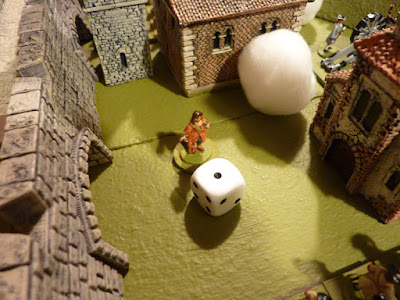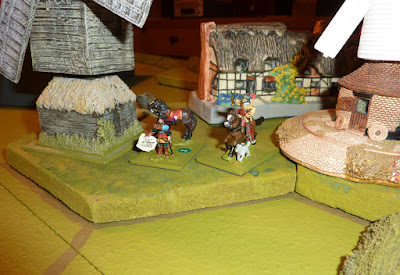My Corporal John game is working well now. It's a card-driven game, derived from Richard Borg's Tricorne, which itself is a Command-&-Colors type boardgame for the AWI. I have come to realise that it would be very useful also to have a variant of the game that can be played without the cards and without the custom Tricorne dice.
1. At present, to play a game via Zoom, each of the participants needs to have the card decks, which is a bit of an overhead if they may never play it again. A different activation system might make this a lot easier.
2. Same problem for remote players and the special dice; it should be a relatively simple task to substitute standard D6s, and just map the required rolls accordingly.
3. Anything which makes Corporal John easier to play by Zoom would be welcome, especially since it is likely that remote play will represent a growing proportion of my gaming in the future. The proposed changes would also make it possible to play with more than 2 players, which is potentially a big step forward.
4. In any case, I need a cardless version of Corporal John to handle the tactical bits of my siege games, and this has been on the shopping list for a year or two.
Enter
CJ Lite, whose name is deliberately as unpretentious as I could make it. At heart, it is still
Corporal John, with
C&C style movement and combat systems, but the fancy dice are replaced by normal D6s, the cards are left in the box and the activation procedure is borrowed (with permission) from Jon Freitag; coloured cubes are drawn from a bag or a "bucket", activating a brigade at a time. Once a brigade is chosen and activated, the game unashamedly reverts to being
C&C until the next cube is drawn.
The Jolly Broom Man very kindly joined me yesterday evening for a first test game, using Zoom. JBM and I have played a lot of Corporal John remotely in the past, but it has only been possible because he has the cards and the dice. Last night's effort was a repeat of the Münzkirchen scenario I played a few weeks ago with David (who also has the cards and dice), so it was useful to have a direct comparison using the new game system.
Outcome? Enjoyable game - one might almost describe it as rollicking; a lot of action, all over the table, and we fought to a result in a little over 3 hours. Considering that we were in uncharted waters for much of the time, and thus had much to discuss, I reckon we should be able to play out such a game (with about 2 dozen units a side) in around 2½ hours when we get good at it.
A lot of useful notes were taken (thanks, JBM) - some things we agreed to change on the fly, some require further thought. There will be some tweaks emerging, but nothing life-threatening. The game works. It was even a lot of fun. The Austrians won again, but then their commander had played the scenario before (and wrote the rules). I shall not bother with a detailed narrative, and I only took a few photos really, but here are some bits of the action to look at. After the pictures I'll mention some thoughts about how the activation system changes the feel of the game.
Miniatures Games Played with Cards
I don't necessarily include games which use normal playing cards as a source of random numbers or cues for events; I'm talking about games such as (in my rather narrow experience) Piquet or the Commands & Colors family, where each player has a hand of cards (i.e. cards published as part of the game or ruleset) which scopes what he/she may do next. Some people hate this with a vehemence which surpasseth understanding - often from some ancient race-memory of a cult war between boardgamers and miniatures fans; some people are disciples of card-controlled games.
Personally, I am quite a fan, but I am aware of some issues, which I shall attempt (sketchily) to mention.
Advantages of Card-driven Games (based on personal experience)
* Can add a lot of narrative colour and some welcome surprises to a game. Some of the narrative colour can be spurious, however; for example, telling a period-specific story about what special training has done to the Stand of Pikes performance of your Foot is just window dressing, if what the card really means is "Order 3 units in your Centre". On the other hand, a scarce card which allows you to issue orders to all your cavalry this turn is not to be sniffed it. Narrative, as they say, lies in the ear of the listener.
* This could be seen as a well-maybe advantage - I like the tendency of C&C type games to have lots of short turns during which you may activate a small number of units. You can't do too much in your turn, but it will be your turn again in just a minute; everyone remains involved. This is one reason why I found C&C stimulating when I first got involved.
* A major plus is that cards can be a big help for the solo-player.
Snags
* Cards can be over-prescriptive, reducing the player's role to acting out some nightmarish, randomly-generated script, which is not always a huge amount of fun (depends what you like, of course). I am not speaking of Piquet, by the way. Well, not necessarily.
* Especially in C&C, generalship can become a firefighting activity, as players try to make some sense of the cards they have been dealt, and find something in there which fits with what they can remember of what they originally planned to do. Not unlike attempting to perform Swan Lake while the audience squirts firehoses at the stage. [feeble analogy, but it amuses me]
* The ritual of reading aloud each played card, to see what is to happen next, and check the players have an agreement of what it means, is a sensible step to include (especially for a project team building a power station) but takes time and can even get a bit wearing.
* Card based games are a no-no for remote play (since everyone has to be equipped with a deck), and coping with multiple players, or hierarchical command, needs special systems. It's possible in a multiple face-to-face game for the appointed commander to delegate cards to his subordinates, but there is a considerable risk that a subordinate may have a rotten time if he is in the wrong bit of the table. [Check your phone texts]
That's really a fairly inadequate stagger through the pros and cons, but it sets out most of what I see as the significant stuff. In the past I developed an alternative, dice-based activation system for C&C games which, among other things, made remote play possible during lockdown. I called this Ramekin (named for the little pot that a player's stash of activation chips is stored in), and I tried to keep the number of new activations each turn consistent with what you might expect from the C&C cards. This worked well enough to keep me playing during the Covid years, but I didn't care for the loss of colour and surprises arising from the loss of the cards, and I particularly disliked what happens if you give a player a small number of activations, even if you don't tell him in which sector of the field to use them.
What happens is what was always intended to happen; the general has to carefully identify priorities, and use his allotted orders shrewdly. Bad news is that the current hot-spots will use up all the orders, it is difficult to generate enough spare orders to start an initiative elsewhere, and the battle develops dead zones where the armies just snarl at each other and not much happens. This became a regular feature of Ramekin, and is why whenever possible I have gone back to the cards in C&C type games.
Last night, the new draw-cubes-from-a-bucket activation system worked well (I've used this type of system in Jon's Zoom games, so I know it works). The system activates a brigade at a time, and these brigades are not so much larger than the number of units activated by a C&C card, but since the process cycles through the brigades (it is unlikely that both armies will get through all their brigades before the Game Turn ends, but that's a detail), it means that there is stuff happening all over the field. By C&C standards, last night's test was a riot.
I had a think about this, and I perceive that the way I [we] play it has to take on board the way the new activations work. In Corporal John, the chances of getting a really useful card in your hand are not always so great, so the instinct is to make use of them, and do as much damage as possible, as and when they turn up. [This, of course, is why any kind of strategic plan in C&C is likely to last a couple of turns at most.]
The new "cube" system is not very like that at all, and one thing I am going to have to think about is that when a brigade is activated it is not necessary to have every constituent unit rushing into the attack, or doing something dramatic. It is possible to have units, or even brigades, which are not supposed to be doing much at the moment. There could be designated reserves who are not simply waiting for a decent card. Suddenly I detect a possibility of strategic thought which may encourage a more nuanced approach to commanding toy armies. Hmmm.
I'm aware I've gone into this particular aspect in rather tedious detail, and I must repeat that thus far I am very pleased with how the new variant works, but an important part of testing is to see how the game will feel. This, after all, is why Corporal John's predecessor in my laboratories, Prinz Eugen, which used more time, effort, cleverness and deep study to produce than the Scottish Parliament building, did not survive testing. It was an interesting game, and it worked, but it was a real drag to play.
Things are looking good. You will hear more of this.























































